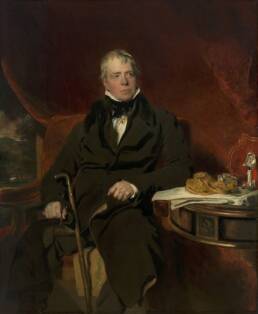These life stories may contain descriptions of childhood trauma and abuse, as well as images, voices and names of people now deceased. If you need help, you can find contact details for some relevant support services on our support page.
Scottish writer, Walter Scott (1771-1832), was in kinship care as a child.
Walter Scott was born to a solicitor and the daughter of a doctor in Edinburgh. When he was eighteen months old, Walter contracted infantile paralysis (or polio) and was lame for the rest of his life.
Because of his ill health, the boy was sent to live with his paternal grandparents at Sandknowe Farm, in the hope that being out of the city would improve his health.
Located 30 miles southeast of Edinburgh in Roxburghshire, Sandyknowe belonged to Walter Scott’s grandparents Robert and Barbara Scott. Scott’s constant companion was his Aunt Janet (Jenny) who would read to him on days when he was unable to venture outside due to his illness… Aunt Jenny not only told Scott stories but also taught him how to read. Although he was at first reluctant, his Aunt’s persistence paid off, and Scott soon became a very competent and enthusiastic reader (Biography).
In 1775, after his grandfather died, Walter returned home to Edinburgh and began school. He was apprenticed to his father in 1786 but was unenthusiastic about a career in law.
In 1805, Scott’s first narrative poem was published to considerable acclaim. It was …
… such a success that he received an unprecedented advance of 1,000 guineas for his second, he was offered the post of poet laureate at the age of 42. At the time, an agricultural labourer would have earned about 40 guineas a year, yet Scott declined the honour and turned to writing novels (Economist).
Scott became a prolific writer.
Many of Scott’s works were hugely popular; the first in the “Waverley” series, published anonymousley, sold out in two days. He made a fortune from them, built a fairy-tale castle called Abbotsford in the Scottish Borders and, after his death in 1832, was commemorated in central Edinburgh by a colossal monument that would not have looked out of place on the launching pad of a 19th- century Cape Canaveral (Economist).
According to John Sutherland (55), Waverley was published anonymously because novel writing was not “an entirely respectable sideline” for Scott in his daytime job as the Clerk to the Court of Session.” It was not until 1826 that Scott was revealed as the author.
Walter Scott demonstrated that a writer could earn a prodigious income while maintaining literary credibility. He is also respected for his lively historical romances and the other genres he inaugurated, for example, the ‘nautical novel’.
Scott’s influenced extended internationally; on his death “the American Richmond Enquirer carried the news in a black-bordered issue, normally only used for American presidents” (Sutherland, 56).
Walter Scott was given the title of baronet in London in 1820, at which time he became Sir Walter Scott, 1st Baronet.
There are numerous ways in which Sir Walter Scott has been memorialised, including with a Memorial Column in George Square, Glasgow and in Central Park, New York City. The Walter Scott Prize is a British literary award founded in 2010 by Scott descendents and is considered one of the most financially significant literary awards in the UK. In Vancouver, British Columbia, Canada, there are twelve streets named after books or characters created by Scott.
In 2021, Scotland celebrated the birth of Sir Walter Scott, who “championed the history and landscapes of Scotland in a string of best-selling books that dominated the 19th century” (Antiquaries).
References:
“250 Years of Sir Walter Scott.” Society of Antiquaries of Scotland. https://www.socantscot.org/resources/250-years-of-sir-walter-scott/
“Walter Scott Biography.” The Walter Scott Digital Archive, Edinburgh University Library. http://www.walterscott.lib.ed.ac.uk/biography/sandy.html
“Sham country, but not sham bard; Scotland and Sir Walter Scott.” The Economist, 31 July 2010.
Sutherland, John. Lives of the Novelists. A history of fiction in 294 lives. London: Profile Books, 2013.
Image available here.
